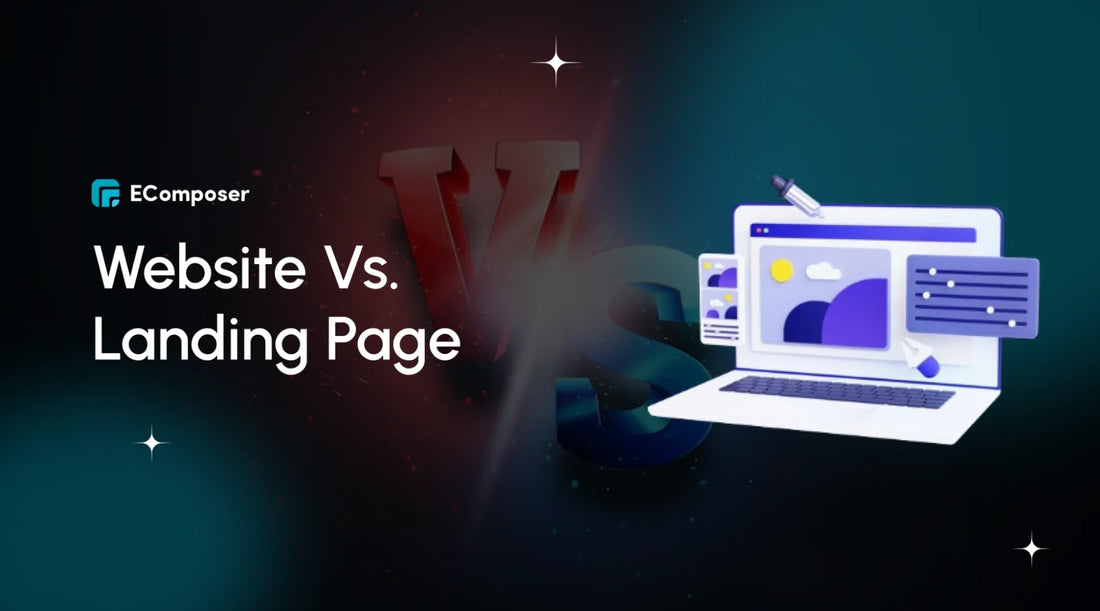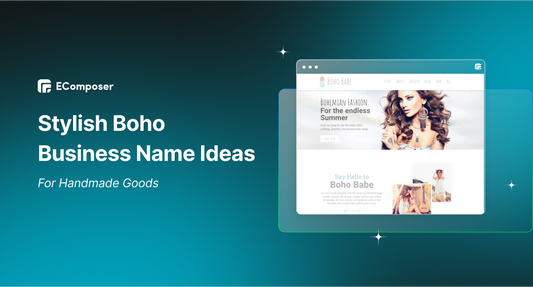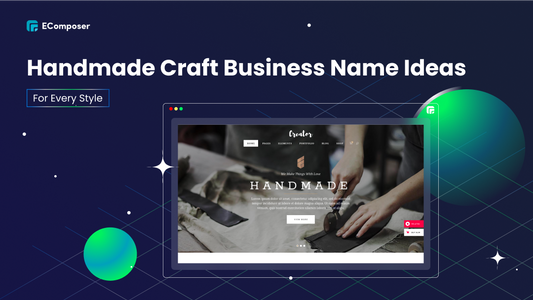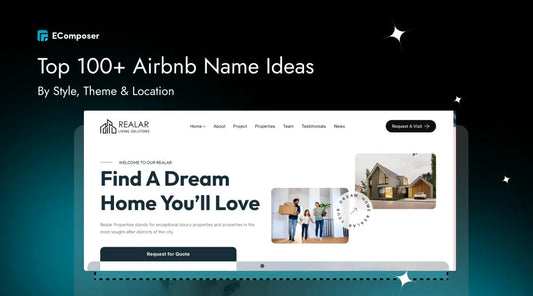Website vs. Landing page: Key Differences & Practical Guide

Table Of Contents
Welcome to our comprehensive guide on the key differences between websites and landing pages! Understanding these distinctions is crucial for optimizing your digital strategy in the dynamic world of online presence. Join us as we demystify these concepts and provide practical insights to help you navigate the realm of web presence effectively. This guide is your go-to resource for making informed decisions and maximizing online impact. Let's dive in!
What is a website?

(image source: Ecomus demo)
A website is a collection of web pages and related content identified by a common domain name and published on at least one web server. It is a central hub for an individual, organization, business, or any entity to establish an online presence. Websites can vary widely in content, functionality, and purpose. They may contain information about the entity, such as its history, products or services, contact information, etc.
Additionally, websites can include various interactive elements such as forms, multimedia content, e-commerce platforms, blogs, forums, and more, depending on the website owner's needs and goals. Overall, websites facilitate communication, information dissemination, marketing, and commerce in the digital age.
Read more: 21+ Most Successful Shopify eCommerce Stores Examples
What is a landing page?

(image source: EComposer Landing Page Template)
A landing page is an independent webpage crafted with a particular goal in focus, typically related to marketing or advertising campaigns. Unlike a typical website with multiple pages and navigation options, a landing page focuses on a single call-to-action (CTA), such as signing up for a newsletter, downloading an ebook, or purchasing.
Landing pages are often used with digital advertising campaigns, email marketing, or social media promotions to drive targeted traffic and encourage conversions. They are designed to be simple, with minimal distractions, and to guide visitors toward taking the desired action.
Explore more: 20+ High Converting Shopify Landing Page Templates
Critical elements of a landing page include:
- Clear and compelling headline: Grabs the visitor's attention and communicates the purpose of the page.
- Concise and persuasive copy: Clearly explains the benefits of taking the desired action and encourages the visitor to act.
- Eye-catching visuals: Relevant images or videos that support the messaging and capture the visitor's interest.
- Call-to-action (CTA): A prominent button or link that encourages visitors to perform the intended action, such as signing up or purchasing.
- Form or contact information: If applicable, a form for visitors to provide their information or contact details to complete the action.
Overall, landing pages are essential for marketers to drive conversions and achieve specific campaign objectives by providing a focused and optimized user experience.
Website vs. landing page: key differences
|
Aspect |
Website |
Landing Page |
|
Purpose & Functionality |
Comprehensive online presence, offering diverse content and functionalities |
Focused on a single objective or campaign, with a clear call to action |
|
Design & Structure |
Multiple pages, interconnected navigation, complex design elements |
Single page, minimal navigation, streamlined design focused on conversion |
|
Content |
Diverse content covering various aspects of the business or organization |
Concise content tailored to a specific offer or campaign |
|
Conversion & Goals |
Multiple conversion paths, including lead generation, brand awareness, and information dissemination |
Singular conversion goal, aiming to maximize conversions for a specific action |
|
Target Audience & Traffic |
It appeals to a broad audience with varied interests, and traffic comes from various sources, including search engines, social media, referrals, etc. |
Targets specific audience segments or campaign objectives, traffic driven through targeted marketing efforts such as ads or email campaigns |
|
Analytics & Tracking |
Tracks various metrics, including page views, time on site, bounce rate, etc., which helps in understanding user behavior |
Focuses on conversion rate, click-through rate, and other metrics related to the CTA, helps in evaluating the effectiveness of marketing campaigns |
What should you choose - A landing page or Website?

The selection between a landing page and a website hinges on your distinct objectives, audience, and the characteristics of your campaign or enterprise.
Choose a Landing Page When
- Running a Specific Campaign: A landing page is ideal for short-term marketing campaigns or promotions with a clear, singular objective (e.g., promoting a new product launch and driving sign-ups for an event). It allows you to focus on driving conversions for that specific goal.
- Launching a New Product or Service: When introducing a new product or service to the market, a landing page can generate buzz and capture leads or pre-orders. It provides a targeted platform to highlight the offering's benefits and features.
- Conducting Paid Advertising: Landing pages prove immensely effective in paid advertising endeavors like Google Ads or Facebook Ads. They uphold message coherence between the advertisement and the landing page, resulting in amplified conversion rates and enhanced ROI.
- Testing and Iteration: If you want to experiment with different messaging, offers, or designs to optimize conversion rates, landing pages allow for rapid testing and iteration. You can quickly identify what resonates best with your audience and adjust accordingly.
- Limited Time Offers or Events: When promoting limited-time offers, discounts, or events, a landing page can generate a sense of urgency to prompt immediate action from visitors. It's an effective way to capitalize on time-sensitive opportunities.
Choose a Website When
- Establishing an Online Presence: A website is essential for long-term brand building and providing comprehensive information about your business, products, and services. It is a central hub for your digital footprint and enables visitors to delve deeper into your company and offerings.
- Catering to Diverse Audience Needs: If you offer multiple products or services, target different customer segments, or provide various types of content (e.g., blog posts, case studies, testimonials), a website offers the flexibility to meet diverse audience needs.
- Building Authority and Trust: A professionally designed website instills credibility and trust in your brand. It lets you showcase your expertise, share valuable content, and interact with visitors by providing engaging blog posts, FAQs, and customer testimonials.
- Supporting SEO Efforts: Websites are critical for search engine optimization (SEO) efforts, allowing you to optimize individual pages for specific keywords and improve your visibility in search engine results. They provide more opportunities to rank for relevant search queries than landing pages.
- Long-Term Marketing Strategy: If your goal is to build a sustainable online presence and foster long-term relationships with customers, a website is the foundation of your digital marketing strategy. It provides a platform for ongoing communication, lead generation, and customer engagement.
In summary, choose a landing page for short-term campaigns, focused conversions, and rapid testing. Choose a website for long-term brand building, comprehensive information sharing, and supporting SEO efforts. Depending on your goals and objectives, you may also use a combination of both to maximize your marketing impact.
How to create a professional website for your business?
Crafting a polished website for your business involves several vital steps to ensure it effectively represents your brand and engages your target audience. Begin your journey with this comprehensive guide:
Step 1: Define Goals & Audience
- Determine the website's purpose: lead generation, sales, and information dissemination.
- Understand the target audience's needs, preferences, and pain points.
Step 2: Choose Domain & Hosting
- Select a memorable domain name reflecting the brand.
- Select a reliable hosting provider equipped with ample resources
Step 3: Select Platform
- Decide on building from scratch or using a website builder (Shopify).
- Consider ease of use, customization, and scalability.
Shopify is a top-notch eCommerce platform that offers excellent features explicitly tailored to create professional online stores. With its intuitive interface and robust functions, Shopify enables you to construct and manage your online storefronts easily while providing scalability to accommodate growth and evolving needs over time.
Step 4: Design Website
- Choose a professional design aligned with brand identity.
- Focus on layout, color scheme, typography, imagery, and navigation.
- Ensure responsiveness and mobile-friendliness.
Leverage EComposer - #1 Drag & Drop Page Builder on Shopify. This app grants you the ability to generate various types of pages, from a homepage or landing page to a product page, etc, for creating a complete ecommerce website fast & easily. The user-friendly interface with a powerful editor suits beginners and experienced merchants. Besides the rich library of stunning premade layouts, EComposer provides excellent features that help your online stores optimize for speed & conversions.

Step 5: Create Compelling Content
- Develop high-quality content for the homepage, about us, products/services, blog, and contact.
- Use persuasive copywriting and multimedia elements to enhance engagement.
Step 6: Optimize for SEO
- Conduct keyword research and incorporate it into content, meta tags, and URLs.
- Optimize page titles, meta descriptions, and image alt text.
- Create and submit sitemap to search engines.
Step 7: Integrate Analytics
- Configure web analytics tools such as Google Analytics.
- Use tracking codes and conversion pixels to monitor campaign effectiveness.
Step 8: Ensure Security & Compliance
- Implement SSL certificates, firewalls, and software updates for security.
- Ensure compliance with regulations like GDPR ADA accessibility guidelines.
Step 9: Test & Iterate
- Test the website across browsers, devices, and screen sizes.
- Gather feedback and make necessary adjustments for usability and functionality.
Step 10: Launch & Promote
- Introduce and promote your website across social media platforms, email marketing, SEO, PPC, and content marketing.
- Monitor performance and optimize based on analytics data and user feedback.
Read more: How to Design a Shopify Store in 10 minutes [2024 Guide]
How to build a high-converting landing page for your website?

(image source: EComposer Landing Page Template)
Building a high-converting landing page requires careful planning, strategic design, compelling content, and continuous optimization.
- Set Clear Goals: Define the landing page objective, which is lead capture, product promotion, sign-ups, or sales. Guide design and content decisions accordingly.
- Know Your Audience: Understand target demographics, interests, pain points, and motivations. Tailor messaging and offer to resonate with their needs.
- Craft a Compelling Headline: Grab attention with concise, benefit-driven headlines. Communicate value proposition using persuasive language.
- Create an Engaging Hero Section: Design a visually appealing hero section with a captivating image or video. Use compelling copy to reinforce headline and outline benefits.
- Highlight Key Benefits: Clearly outline key benefits in bullet points or paragraphs. Focus on solving the audience's problem or fulfilling their needs.
- Include a Strong Call-to-Action (CTA): Place a prominent, action-oriented CTA button above the fold. Clearly indicate the desired action with persuasive language and contrasting colors.
- Optimize Form Fields: Keep form fields short and relevant, asking for essential information only. Minimize friction by reducing required fields and using intelligent defaults.
- Add Social Proof: Increase credibility with customer testimonials, reviews, case studies, or trust badges. Highlight positive feedback to reassure visitors.
- Create Urgency or Scarcity: Encourage immediate action with urgency elements like countdown timers or limited-time offers. Motivate visitors to act quickly.
- Design for Mobile Responsiveness: Ensure the landing page is optimized for mobile devices. Use responsive design principles and test across different screen sizes for compatibility.
- A/B Test and Optimize: Conduct A/B tests on headlines, images, CTAs, form fields, and layouts. Analyze results to improve conversion rates over time.
- Track and Analyze Performance: Implement tracking tools like Google Analytics to monitor visitor behavior and conversion rates. Use data analytics to refine the landing page for maximum effectiveness.
Explore more: How to Create a Landing Page in Shopify: 8 Effective Examples
Final thoughts
In conclusion, understanding the differences between a website and a landing page is essential for creating effective online marketing strategies. By clarifying your goals, knowing your audience, and implementing the best practices outlined in this practical guide, you can leverage the strengths of both websites and landing pages to maximize your online presence and achieve your marketing objectives.
FAQs - Website vs. Landing Page

1. What is the main difference between a website and a landing page?
Answer: Websites serve as comprehensive online platforms for businesses to showcase their offerings and engage with diverse audiences, while landing pages are focused, conversion-driven tools designed to capture leads or promote specific campaigns.
2. When should I choose a website over a landing page?
Answer: Websites are ideal for establishing a long-term online presence, providing comprehensive information about your business, catering to diverse audience needs, and supporting various conversion goals.
3. In what scenarios would a landing page be more suitable?
Answer: Landing pages are highly effective for short-term marketing campaigns, specific conversion objectives, targeted audience segments, and rapid testing and iteration to optimize conversion rates.
4. What are some factors to consider when deciding between a website and a landing page?
Answer: Several factors warrant consideration when determining your choice. These include the campaign objectives, target audience, conversion focus, and budget/resources.
Campaign Objectives
- Landing Page: Ideal for short-term campaigns with clear conversion goals.
- Website: Suited for long-term branding and catering to diverse audience needs.
Conversion Focus
- Landing Page: Focused design for driving conversions for a single action.
- Website: Offers flexibility for a broader range of conversion goals.
Audience Targeting
- Landing Page: Highly effective for targeting specific audience segments.
- Website: Provides a platform catering to a broader audience with varied interests.
Budget and Resources
- Landing Page: Quicker and cheaper to create, suitable for short-term campaigns.
- Website: Requires more investment but offers long-term benefits and flexibility.
5. How do I know if my goal is better suited for a website or a landing page?
Answer: A website is preferable if your goal is to provide comprehensive information, cater to diverse audience needs, and support multiple conversion paths. However, a landing page may be more effective if you have a specific short-term campaign or conversion objective.
6. Can I have both a website and landing pages for my business?
Answer: Many businesses utilize websites and landing pages in their marketing strategies. Websites provide a central hub for your online presence while landing pages can be used to target specific campaigns, promotions, or audience segments.
7. How can I ensure my landing page is optimized for conversions?
Answer: To optimize your landing page for conversions, focus on clear goal definition, audience targeting, compelling headlines, engaging content, strong CTAs, streamlined form fields, social proof, urgency/scarcity elements, mobile responsiveness, and continuous testing and optimization.
8. What are the benefits of using a website builder for creating landing pages?
Answer: Website builders like Shopify offer user-friendly interfaces, customizable templates, scalability, integration capabilities, and built-in optimization features, making it easier to create and manage high-converting landing pages.
9. How do I measure the effectiveness of my website or landing page?
Answer: You can measure effectiveness through web analytics tools, tracking key metrics such as traffic, user behavior, conversion rates, bounce rates, and engagement. Use data insights to identify areas for improvement and optimize performance.
10. What are some common mistakes to avoid when creating websites or landing pages?
Answer: Common mistakes include unclear goals, lack of audience understanding, poor design/layout, ineffective copywriting, weak CTAs, excessive form fields, lack of social proof, neglecting mobile optimization, and failure to test and iterate for improvements.






















0 comments